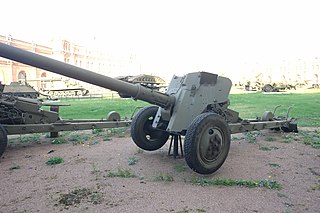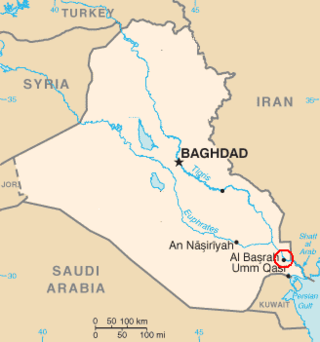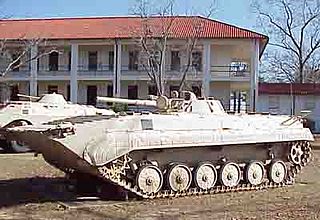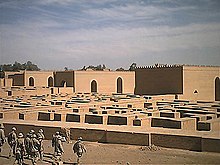
The 101st Airborne Division (Air Assault) ("Screaming Eagles") is a light infantry division of the United States Army that specializes in air assault operations. It can plan, coordinate, and execute battalion-sized air assault operations to seize terrain. These operations can be conducted by mobile teams covering large distances, fighting behind enemy lines, and working in austere environments with limited or degraded infrastructure. For example, it was active in foreign internal defense and counterterrorism operations in Iraq, in Afghanistan in 2015–2016, and in Syria, as part of Operation Inherent Resolve in 2018–2021.

The Iraqi Republican Guard was a branch of the Iraqi military from 1969 to 2003, which existed primarily during the presidency of Saddam Hussein. It later became known as the Republican Guard Corps, and then the Republican Guard Forces Command (RGFC) with its expansion into two corps. The Republican Guard was disbanded in 2003 after the invasion of Iraq by a U.S.-led international coalition.

The Gulf War was an armed conflict between Iraq and a 42-country coalition led by the United States. The coalition's efforts against Iraq were carried out in two key phases: Operation Desert Shield, which marked the military buildup from August 1990 to January 1991; and Operation Desert Storm, which began with the aerial bombing campaign against Iraq on 17 January 1991 and came to a close with the American-led liberation of Kuwait on 28 February 1991.

This is a timeline of the events surrounding the United States-led invasion of Iraq in 2003.

The Battle of Baghdad, also known as the Fall of Baghdad, was a military engagement that took place in Baghdad in early April 2003, as part of the invasion of Iraq.

The Battle of Khafji was the first major ground engagement of the Gulf War. It took place in and around the Saudi Arabian city of Khafji, from 29 January to 1 February 1991.

The Battle of 73 Easting was fought on 26 February 1991, during the Gulf War, between Coalition armored forces and Iraqi armored forces. It was named for a UTM north–south coordinate line that was used as a phase line by Coalition forces to measure their progress through the desert. The battle was later described by Lt. John Mecca, a participant, as "the last great tank battle of the 20th century." This battle took place several hours after another, smaller, tank battle at Al Busayyah.

The Battle of Medina Ridge was a tank battle fought on the 27 February 1991, during the Gulf War, between the U.S. 1st Armored Division and the 2nd Brigade of the Iraqi Republican Guard Medina Luminous Division outside Basra, Iraq. The U.S. 3rd Brigade, 3rd Infantry Division, was also a major contributor, by leading the attack. Iraq's Adnan Motorized Division was also a participant. Medina Ridge is the name American troops gave to a low rise, approximately seven miles (11 km) long.

The Battle of Norfolk was a tank battle fought on February 27, 1991, during the Persian Gulf War, between armored forces of the United States and United Kingdom, and those of the Iraqi Republican Guard in the Muthanna Province of southern Iraq. The primary participants were the U.S. 2nd Armored Division (Forward), 1st Infantry Division (Mechanized), and the Iraqi 18th Mechanized and 9th Armoured Brigades of the Republican Guard Tawakalna Mechanized Infantry Division along with elements from eleven other Iraqi divisions. The 2nd Armored Division (Forward) was assigned to the American 1st Infantry Division as its 3rd maneuver brigade due to the fact that one of its brigades was not deployed. The 2nd Armored Division (Forward)'s Task Force 1-41 Infantry would be the spearhead of VII Corps. The British 1st Armoured division was responsible for protecting the right flank of VII Corps, their main adversary being the Iraqi 52nd Armored Division and multiple infantry divisions. It was the final battle of the war before the unilateral ceasefire took effect.

The Battle of Abu Ghraib took place between Iraqi Mujahideen and United States forces at Abu Ghraib prison on April 2, 2005.

The 1st Battalion, 227th Aviation Regiment is an attack helicopter battalion of the 1st Air Cavalry Brigade, 1st Cavalry Division. The battalion is an AH-64 Apache battalion based at Fort Cavazos, Texas.

The Battle of Wadi al-Batin, also known as the Battle of Ruqi Pocket, took place before the beginning of the Desert Storm operations on 16 February 1991. This is not to be confused with the "Battle of Wadi al-Batin" which was fought later in the four-day ground war between elements of the 1st Cavalry Division and the Iraqi Republican Guard.

The Battle of Basra began on 25 March 2008, when the Iraqi Army launched an operation to drive the Mahdi Army militia out of the southern Iraqi city of Basra. The operation was the first major operation to be planned and carried out by the Iraqi Army since the invasion of 2003.

The Battle of the Karbala Gap occurred during the 2003 invasion of Iraq. The Karbala Gap is a 20–25-mile wide strip of land with the Euphrates River to the east and Lake Razazah to the west. This strip of land was recognized by Iraqi commanders as a key approach to Baghdad, and was defended by the Medina and Bakhtnisar Divisions of the Iraqi Republican Guard. American forces attacked Iraqi forces in the area with massive air attacks followed by concentrated armored thrusts which resulted in the Iraqi units being surrounded and annihilated.

The Battle of Karbala took place during the 2003 invasion of Iraq as U.S. troops fought to take control of the city from Iraqi forces. The city had been bypassed during the advance on Baghdad, leaving American units to clear it in two days of street fighting against Iraqi Saddam Fedayeen Irregular forces.

The Battle of Najaf was a major battle in the 2003 U.S. invasion of Iraq. The first stage of the battle was fought when the U.S. 3rd Infantry Division fought to surround the town. The second stage was fought when soldiers from the U.S. 101st Airborne Division fought to clear and secure the city.

The Battle of Rumaila, also known as the Battle of the Causeway or the Battle of the Junkyard, was a controversial attack that took place on March 2, 1991, two days after President Bush declared a ceasefire, near the Rumaila oil field in the Euphrates Valley of southern Iraq, when the U.S. Army forces, mostly the 24th Infantry Division under Major General Barry McCaffrey engaged and nearly annihilated a large column of withdrawing Iraqi Republican Guard armored forces during the immediate aftermath of the Gulf War.
Al Rasheed Air Base is a major Iraqi Air Force base on the southeastern outskirts of Baghdad, in Diyala Governorate of Iraq.

Task Force 1-41 Infantry was a U.S. Army heavy battalion task force which took part in the Gulf War of January – March 1991. It was also known as Task Force Iron. Task Force 1-41 Infantry was the first coalition force to breach the Saudi Arabian border on 15 February 1991 and conduct ground combat operations in Iraq engaging in direct and indirect fire fights with the enemy on 17 February 1991. It was the spearhead of VII Corps. The Task Force served at the Battle of 73 Easting and the Battle of Norfolk where it was assigned to the U.S. 1st Infantry Division. It engaged and destroyed elements of 11 Iraqi divisions by the end of combat operations. This includes a significant role in the destruction of 4 Iraqi armored brigades at the Battle of Norfolk. Task Force 1-41 Infantry was awarded a Valorous Unit Award for its accomplishments during combat operations. It consisted primarily of the 1st Battalion, 41st Infantry Regiment, 3rd Battalion, 66th Armor Regiment, and the 4th Battalion, 3rd Field Artillery Regiment all being part of the 2nd Armored Division (Forward), based at Lucius D. Clay Kaserne, 24 kilometres (15 mi) north of Bremen, in the Federal Republic of Germany. Task Force 1-41 was commanded by Lieutenant Colonel James L. Hillman.

The 'Al-Medina' Armored Division was an elite formation of the Iraqi Republican Guard.


















